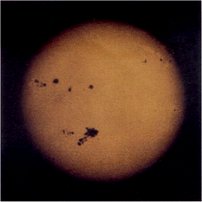What are sunspots? Literally, they are just "spots" on the sun. Physically, they are dark irregular areas of lower temperature (as compared to other regions of the sun) that are found on the photosphere.
The structure of sunspots basically consists of penumbra and umbra. Umbra is the dark central core of a sunspot, and penumbra is the slightly brighter part of the sunspot.

pic modified from src: Universe (Fifth Edition)
Why are sunspots dark? This is due to the fact that umbra only emits 30% as much light as a patch of undisturbed photosphere of the same dimension. Hence, sunspots "appears" to be dark, as compared with a much brighter photosphere. Without the photosphere, the sunspots appear to be red at the umbra and orange at the penumbra.
Sunspots are usually found in at least pairs or groups, with one leading (and biggest) sunspot and several following sunspots. They occur in regions called active regions. At the initial stage, the spots are highly inclined to a parallel of latitude. A typical sunspot group lasts for two months. The leading sunspot is usually the more westerly spot and is closer to the Sun's Equator.


Solar Maxima Solar Minima
pic modified from src: Universe (Fifth Edition)
The number of sunspots changes periodically according to the Sun's activity. When the Sun is very active, the number of sunspots will reach a maximum. This is called solar maxima. On the other hand, when there is almost no sunspots to be seen, the period of low activity is called solar minima. The number of sunspots gradually increase and fall in a certain pattern, and a sunspot cycle can be observed.
The sunspot pairs or groups are bipolar. The leading sunspots in northern hemisphere have north magnetic polarity and those in southern hemisphere have south magnetic polarity. The following sunspots have the opposite polarity as compared with the leading sunspot in each hemisphere. The intermediate sunspots - spots which lie between the leading and the following sunspots - have both polarities.
It is observed that the polarity of the leading sunspots switches every 11 years. Since the sunspots in the northern hemisphere should have the north magnetic polarity, this indicate that the Sun actually "switches" its Poles. For the Sun to revert the Poles back to their original positions, the time taken is 22 years. This period / situation is called the solar cycle.
Pictures © "Universe (Fifth Edition)"
Page © of GEM1506K, Group 2 (http://www.oocities.org/sg/apollonus02)